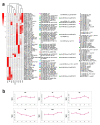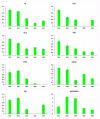The Integrated mRNA and miRNA Approach Reveals Potential Regulators of Flowering Time in Arundina graminifolia
- PMID: 36675213
- PMCID: PMC9865619
- DOI: 10.3390/ijms24021699
The Integrated mRNA and miRNA Approach Reveals Potential Regulators of Flowering Time in Arundina graminifolia
Abstract
Orchids are among the most precious flowers in the world. Regulation of flowering time is one of the most important targets to enhance their ornamental value. The beauty of Arundina graminifolia is its year-round flowering, although the molecular mechanism of this flowering ability remains masked. Therefore, we performed a comprehensive assessment to integrate transcriptome and miRNA sequencing to disentangle the genetic regulation of flowering in this valuable species. Clustering analyses provided a set of molecular regulators of floral transition and floral morphogenesis. We mined candidate floral homeotic genes, including FCA, FPA, GI, FT, FLC, AP2, SOC1, SVP, GI, TCP, and CO, which were targeted by a variety of miRNAs. MiR11091 targeted the highest number of genes, including candidate regulators of phase transition and hormonal control. The conserved miR156-miR172 pathway of floral time regulation was evident in our data, and we found important targets of these miRNAs in the transcriptome. Moreover, endogenous hormone levels were determined to decipher the hormonal control of floral buds in A. graminifolia. The qRT-PCR analysis of floral and hormonal integrators validated the transcriptome expression. Therefore, miRNA-mediated mining of candidate genes with hormonal regulation forms the basis for comprehending the complex regulatory network of perpetual flowering in precious orchids. The findings of this study can do a great deal to broaden the breeding programs for flowering time manipulation of orchids.
Keywords: bamboo orchid; floral integrators; hormones; micro RNA; multi-omics.
Conflict of interest statement
The authors declare no conflict of interest.
Figures






References
-
- Zhan Q., Liang Y., Zhang Z., Liu F., Li L., Tang X., Liang Z., Chen W., Hu M., Tan S. Geographic Patterns of the Richness and Density of Wild Orchids in Nature Reserves of Jiangxi, China. Diversity. 2022;14:855. doi: 10.3390/d14100855. - DOI
-
- Seidenfaden G., Wood J.J., Holttum R.E. The orchids of peninsular Malaysia and Singapore. Olsen & Olsen; Midvale, UT, USA: 1992.
MeSH terms
Substances
Grants and funding
- NZ2021010/Laboratory for Lingnan Modern Agriculture Project
- 2017A030312004/Natural Science Foundation of Guangdong province
- 2018YFD1000400 and 2019YFD1001003/National Key R&D Program
- 201707010307/Guangzhou Science and Technology Project
- 2021KJ121/Innovation Team of Modern Agricultural Industry Technology System in Guangdong Province
LinkOut - more resources
Full Text Sources
Research Materials

